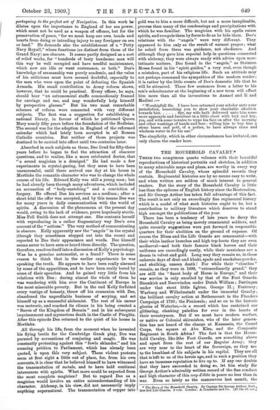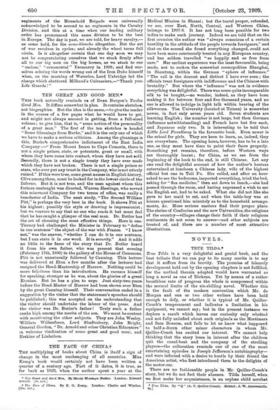THE HOUSEHOLD CAVALRY.* THESE two sumptuous quarto volumes with their
beautiful reproductions of historical portraits and sketches, in addition to many admirable maps and plans, are worthy in every way of the Household Cavalry, whose splendid records they contain. Regimental histories are by no means easy to write, and when written are seldom of much interest to general readers. But the story of the Household Cavalry is little less than the epitome of English history since the Restoration, and Sir George Arthur has taken full advantage of this fact. The result is not only an exceedingly fine regimental history which is a model of what such histories ought to be, but a contribution to military literature which deserves to stand high amongst the publications of the year.
There has been a tendency of late years to decry the Household Cavalry as being merely ornamental soldiers, and quite recently suggestions were put forward in responsible quarters for their abolition on the ground of expense. Of course the Blues and the Life Guards are ornamental—with their white leather breeches and high top-boots they are even mediaeval—and both their famous black horses and their uniforms are exceedingly costly, while their musicians are a dream in velvet and gold. Long may they remain so, in these unheroic days of drab and khaki, spade and smokeless powder, and skulking, unseen death ! For while their " cloathes " remain, as they were in 1699, "extraordinarily grand," they are still the "finest body of Horse in Europe," and their war service is only excelled by that of the Foot Guards. Steenkirk and Neerwinden under Dutch William ; Dettingen under that stout little fighter, George II.; Fontenoy ; Warburg and Wilhelmstadt under the immortal Granby ; the brilliant cavalry action at Bethencourt in the Flanders Campaign of 1793; the Peninsula; and so on to the historic glories of Waterloo,—is a record which has enshrined our glittering, clanking paladins for ever in the hearts of their countrymen. But if we must have modern warfare, or native or Colonial skirmishes, who of the later genera- tion has not heard of the charge at Kassassin, the Camel Corps, the square at Abu Klea, and the Composite Regiment in South Africa P The fact is that the House- hold Cavalry, like [the Foot Guards, are something above and apart from the rest of our Regular Army; they are very near to the heart of the Sovereign, as they are to the humblest of his subjects in his capital. They are all that is left to us of the heroic age, and in such a position they have an immense reputation to live up to. If any one doubts that they have succeeded in doing so, let him study Sir George Arthur's admirably written record of the fine conduct and high character of this corp d'ilite in peace no less than in war. Even so lately as the manceuvres last month, the • The Story of the Housshold Cavalry. By Captain Sir George Arthur, Bart., late 2nd Life Guards. 2 vols. London : A. Constable and Co. [23 13s. 6d. net.1 regiments of the Household Brigade were universally acknowledged to be second to no regiments in the Cavalry Division, and this at a time when our leading military critic has pronounced this same division to be the best in Europe. The day is past, we are told, for heavy cavalry,— as some hold, for the arme-blanche altogether. But the art of war revolves in cycles; and already the wheel turns full cirole. Is it altogether certain that one day soon we may not be congratulating ourselves that we stuck firmly after all to our big men on the big horses, as we stuck to our "-useless," " ornamental " Yeomanry in 1898; and find our- selves echoing the words wrung out of the Iron Duke himself when, on the morning of Waterloo, Lord Uxbridge led the charge which shattered Milhaud's Cuirassiers,--"Thank you. Life Guards ! "











































 Previous page
Previous page